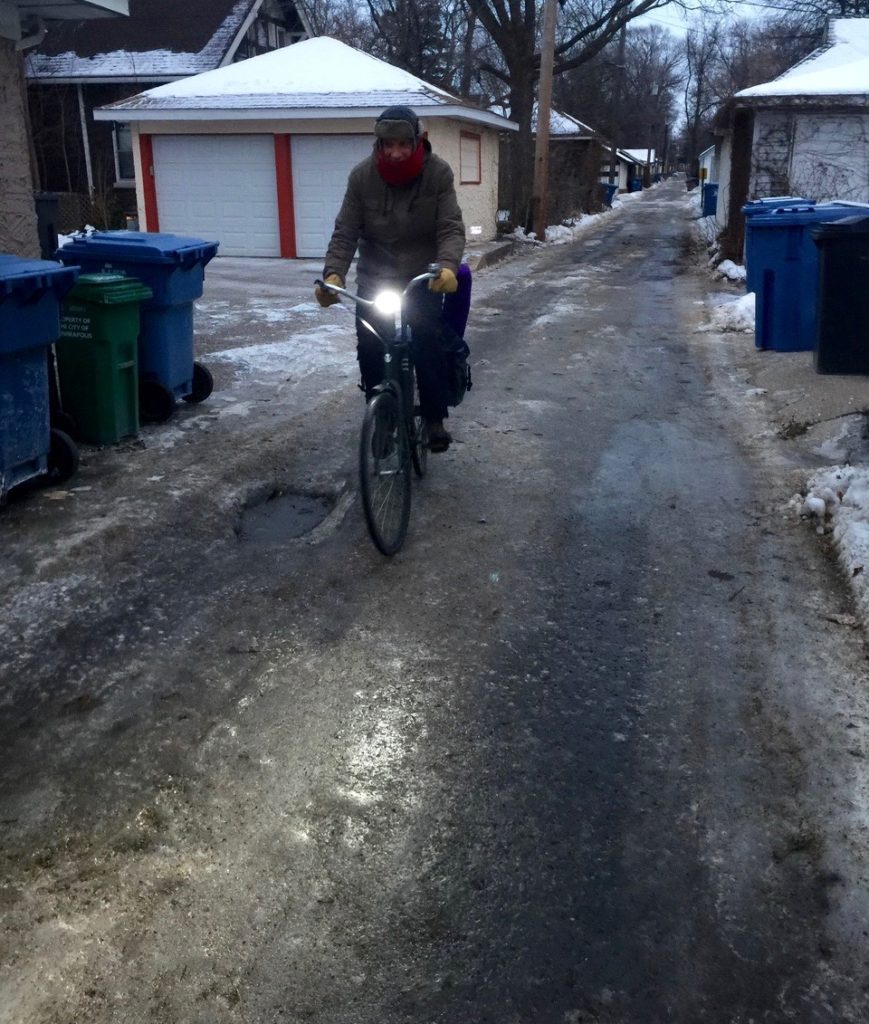Today while checking out at the Seward Coop, the cashier, a woman I scarcely know, told me that when she thinks about winter biking – she thinks about me! Flattered, it made me reflect on the fact that I have been riding in the winter now some 15 long, cold years!! Long enough that, it seems to me, I am qualified to, humbly, share some of the lessons I have learned with you my dear fellow riders. I thought the first dispatch should be about your bike.
First, I want to make it clear that it is possible for one to ride in the winter with any bike! My first years riding in the winter were spent on the bike you see me riding in the Minneapolis video, it was a Schwinn Collegiate five speed. It lasted many years until it finally, like the Tin Man in The Wizard of Oz, froze solid with rust. And although I considered my early riding years to be a big success, I can remember falling once the first year so hard I nearly broke my leg and later that season cracking a rib. So, here are my top recommendations for creating your safe winter bike.
1. No surprise here, studded tires. When I started I had no idea they existed, now I would never ride without them. Unfortunately, they don’t manufacture ones that work with 27” wheels. Most cheap bicycle-boom, Carter Era, 70’s to 80’s $100 – $200 bikes you find on Craigslist use 27” tires. Too bad!! because otherwise they would make excellent sacrificial winter bikes. There are studded tire options for 26” wheels but they are, at their narrowest, what I would call “mountain bike” width. These are the tires I currently ride and I love them, they fit 700c wheels. Notice they have no studs in the center of the tire because, let’s face it, even in the winter we spend 90% of the time riding on pavement. On these tires, the studs only come into play if the tire tilts a little, as can happen on snow or ice, or when turning, but are out of the way when I am stably rolling on dry pavement.
2. Single speed freewheel, fixed cog, or internal hub gears on the rear wheel. I don’t think it remained a 5 speed for more than a couple months before the sprocket got rusty and all gummed up I was forced to rid the bike of all that hoo-ha on the rear wheel. The sometimes crabby guy at Freewheel removed the sprocket, pie plate and derailer for me, I’ll never forget it, it made me, (and even him!) happy.
3. Fenders. Strangely enough this is more out of concern for your bike than for you, dear rider. Of course, aesthetically, they are very pleasing as well! And one, happily, doesn’t get a wet back!
4. Upright handlebars. I have always ridden with them and I just feel more stable at slow speeds this way. I’ve been tempted to try drops, due to the fact cyclocross riders use them, but I haven’t yet felt the need to change. If I were commuting 8 miles to work, rather than 2, I would feel much more motivated to give them a try.
5. An extremely powerful headlight. This has been a sea change and makes me feel more confident and safer on the roads. I can even see the change in behavior in motorists when I have my light on. They respect me more, i.e. give me more room. In pitch-dark situations you can actually see the ruts you need to follow. Unfortunately, they need to be off, or at least dimmed, on the bike trail or you risk blinding the oncoming cyclist. The good old-fashioned tail light, two AAA battery sort, still seems to be quite adequate.
6. Panniers or some sort of large bag. In winter, naturally, you wear more clothing. Having panniers means if you start shedding clothing you have a place to store it. Sometimes you may need to add clothing. I usually bring my choppers with me even if it is relatively warm outside, I also bring a pair of shoes to work with me everyday to change into. I bought the winter bike I ride today for the primary reason that it had a rear rack that would accommodate my Dutch panniers.
So there it is, I hope some of it is useful to you. Biking, it’s not just for summer anymore!
Yours in (Winter) Cycling,
Jim

